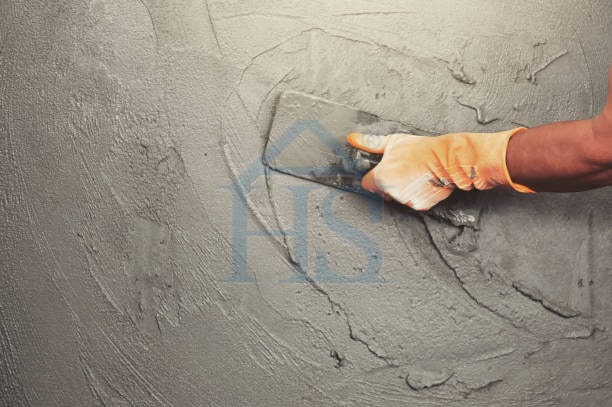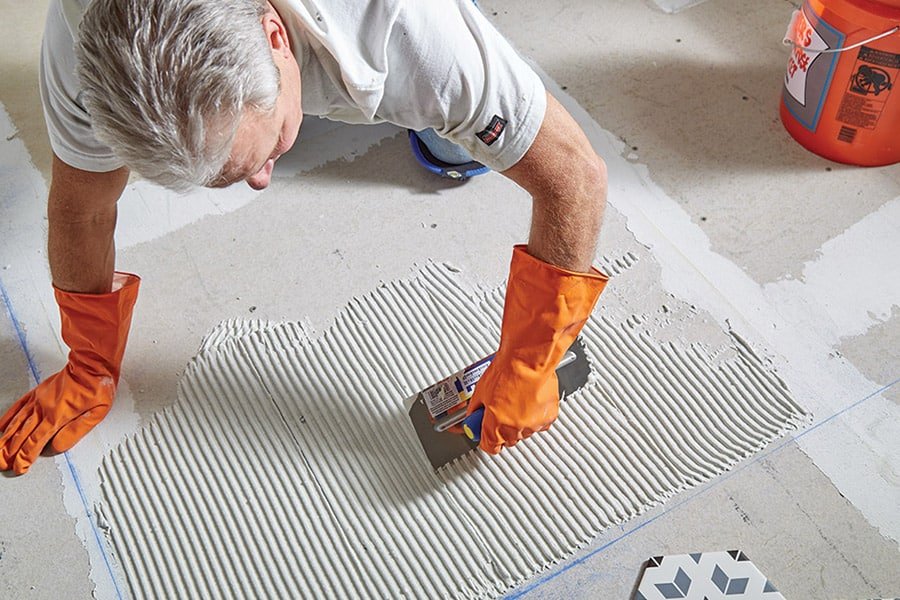As a by-product of ferrosilicon smelting, silica fume can be incorporated into concrete to improve its strength and corrosion resistance, and can also be incorporated into refractory castables to improve their performance. As a kind of finishing material for later decoration, gypsum-based self-leveling mortar can also be mixed with silica fume to improve the performance, Henan Superior Abrasives has compiled the effect of silica fume on the performance of gypsum-based self-leveling mortar and the test process, hoping to deepen your understanding of silica fume.
Test of silica fume incorporated into gypsum-based self-leveling mortar
Test raw materials
- Cementitious materials: high-strength gypsum powder, P-O42.5 grade cement;
- Aggregate, filler: 0.18~0.42mm quartz sand, 0.04mm bicarbonate;
- Admixtures: Wacker 5010 dispersible emulsion powder, tartaric acid retarder, carboxypropyl methyl cellulose water retention agent, polycarboxylic acid water reducing agent, organosilicon oil defoamer;
- Silica fume : Silica fume produced by Henan Superior Abrasives.
| Chemical Composition of Gel Materials and Silica Fume% | |||||||||
| type | SiO2 | Al2O3 | Fe2O3 | MgO | CaO | Na2O | K2O | SO3 | Loss on ignition |
| plaster | 0.22 | 0.13 | — | 0.04 | 36.65 | — | 0.10 | 56.78 | 5.50 |
| cement | 20.75 | 4.35 | 2.80 | 0.78 | 64.52 | 0.16 | 0.52 | 2.30 | 3.44 |
| silica fume | 94.88 | 0.82 | 0.69 | 0.60 | 0.19 | 0.78 | — | — | 1.37 |
Test proportioning
The ratio of gypsum-based self-leveling mortar system is high-strength gypsum powder, cement, quartz sand and heavy calcium carbonate. Among them, cement 10%, quartz sand 10% and bicarbonate 10%. Silica fume replaces part of the high-strength gypsum powder, and the proportion of high-strength gypsum powder starts from 70% and decreases by 3% each time until 55%, while the proportion of Silica fume increases from 0 to 15%. Additives are mixed according to the total mass of mortar system, the dosage of re-dispersible emulsion powder, retarder, water retention agent, water reducing agent and defoamer are 1.0%, 0.02%, 0.5%, 1.0% and 0.02% respectively. The ratio of water to material is 1:0.20.
Test method
Specimen preparation and its physical and mechanical properties test: according to JC/T 1023-2007 “gypsum-based self-leveling mortar” requirements, the raw materials to determine the ratio of water and mix thoroughly to obtain a homogeneous slurry and molding, to determine the 30min flow loss, setting time, strength and shrinkage rate of mortar.
Water resistance test: water resistance is usually expressed by softening coefficient, and the ratio of compressive strength of the specimen in the saturated state of water absorption to that in the dry state is the softening coefficient. Two groups of standard specimens are maintained to 28d age, and then one group of specimens is immersed in distilled water at (23±2)℃ for 48h, and the specimens are taken out to test their quality and compressive strength, and the water absorption rate and softening coefficient are calculated.
Effect of micro silica fume on the performance of gypsum-based self-leveling mortar
Physical and mechanical properties
(1) The test shows that when the amount of silica fume is increased from 0 to 6%, the initial flow of mortar increases continuously with a larger magnitude, and the 30min flow loss decreases; from 6% to 15%, the initial flow decreases slowly, and the 30min flow loss increases. Meanwhile, with the increase of silica fume admixture, the initial and final setting time are gradually shortened, and the setting time shows a proportional decreasing trend.
(2) Silica fume in the formation process, due to the phase change by the role of surface tension, the formation of amorphous spherical particles of amorphous phase, and the surface is relatively smooth. The material mixed with a relatively small amount of silica fume, the tiny spherical body can play the role of lubrication, so that the entire gypsum slurry has better water retention and improved fluidity. However, because silica fume has volcanic ash activity, more water molecules adhere to the surface of silica fume particles when the doping amount continues to increase, the adsorption effect on water is very obvious, reducing the content of free water in the system, resulting in a lower mortar flow.
(3) The adsorption effect of silica fume on water will cause the initial and final setting time to be shortened with the increase of silica fume. With the increase of silica fume, the 30min flow loss decreases and then increases, and the setting time is shortened, therefore, the workability of gypsum-based self-leveling mortar can be improved by appropriate mixing of silica fume.
(4) When the admixture of silica fume was increased from 0 to 12%, the 28d flexural and 24h and 28d compressive strengths increased continuously and significantly, except for the 24h flexural strength, and all of them reached the limit value at 12% admixture; from 12% to 15%, the flexural and compressive strengths were reduced.
(5) The 28d tensile bond strength of mortar increased with the increase of silica fume dosing. silica fume has very small particle size and fills in the surface of gypsum particles as well as in the mortar voids, which makes the mortar structure more compact and reduces the porosity, thus improving the strength.
(6) With the increase of silica fume admixture, the 24h compressive, 28d flexural and compressive strengths are significantly increased, except for the 24h flexural strength which is slightly reduced, and the 28d tensile bonding strength is slightly increased.
(7) The 28d shrinkage of gypsum-based self-leveling mortar varied less, about 0.03%, when the amount of silica fume was mixed in the range of 0~15%. Relative to the mortar without silica fume, the shrinkage variation of gypsum-based self-leveling mortar did not fluctuate much. Shrinkage affects the adhesion of gypsum-based self-leveling mortar to the ground, surface deformation, mid-layer voids and cracks, etc. silica fume is used in gypsum-based self-leveling mortar and fills in the mortar voids, which has good filling effect and effectively reduces the drying shrinkage value.
(8) After the gypsum-based self-leveling mortar hardens, the evaporation of excess water inside it will form loose and porous mesh structure inside the mortar, and these mesh structures lead to lower mortar strength and poor water resistance. The addition of silica fume can make the gypsum-based self-leveling mortar change the contact form between gypsum crystals under the condition of achieving the same flow degree, so as to increase the strength and improve the water resistance.
Water resistance
The water absorption rate of gypsum-based self-leveling mortar tends to rise first and then fall when the amount of silica fume is gradually increased. When the amount of silica fume is 9%, the water absorption rate reaches the peak of 0.17, and then the water absorption rate decreases.
On the one hand, the hydration product formed by the hydration of silica fume has the characteristics of good denseness and low water absorption, which fills in the internal pores of the gypsum mortar and prevents part of the water from entering the interior of the material, effectively reducing the water absorption rate. On the other hand, the specific surface area of silica fume is much larger than that of gypsum, and more water molecules attach to the surface of silica fume particles, which connect the silica fume particles through surface tension, thus realizing the water-locking effect.
The compressive strength and softening coefficient of gypsum-based self-leveling mortar both show a rising and then decreasing trend when the amount of silica fume is gradually increased. When 6% of silica fume was added, the softening coefficient was 0.55, which increased by 15% compared with that without silica fume. This is mainly because the hydration product of silica fume is insoluble in water and fills in the internal pores of the slurry, which effectively increases the strength of the gypsum-based self-leveling mortar in the water-absorbing saturated state, thus improving the water resistance. However, when the amount of silica fume is too much, the generated hydration products are expansive and have a destructive effect on the structure formed by the gelling system, which makes the softening coefficient decrease. To sum up, the softening coefficient of gypsum-based self-leveling mortar reaches the limit when the amount of silica fume is 6%.
The effect of silica fume on the performance of gypsum-based self-leveling mortar was found to be mainly in the improvement of fluidity, workability, and shortening of setting time, while the dosing of silica fume should be in the range of 10% in order to ensure better performance, comprehensive physical and mechanical properties and water resistance. At the same time, we can also produce microsilica with different contents and uses according to the different needs of customers, including silica fume for gypsum-based self-leveling mortar.





